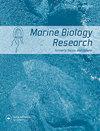Reproductive biology of mangrove clams Geloina expansa (Mousson, 1849) from mangrove at Kendari Bay, Southeast Sulawesi, Indonesia
IF 1.2
4区 生物学
Q4 ECOLOGY
引用次数: 2
Abstract
ABSTRACT Mangrove clams are found in the soft substrates of the mangrove forest, where they reproductively adjust to the conditions in the aquatic environment. This study aimed to determine the reproductive biology pattern, such as sex ratio, gonad maturity level, gonadosomatic index, fecundity and size of the first maturity of mangrove clams. The samples included 80 ind./month collected manually from the mangrove ecosystem for one year. The reproductive biology patterns were calculated using standard formulas, each analysed using the χ2 test, semi-quantitative descriptive evaluation and non-linear regression. The results showed that more males than females were collected, accounting for 80.0–96.5% and 3.4–20.0%, respectively. Furthermore, both sexes’ gonad maturity developments coincided. The mangrove clam’s mature gonads are discoverable all year by observing the gonadosomatic index IV and spawning monthly occurrence. Their maturity peaked (levels III and IV) in February–April, indicated by a high index value ranging from 3.9–18.2 and 4.3–21.9 for the male and female mangrove shells, respectively. The male clams also had smaller sizes at maturity than females at 3.0 and 5.2 cm lengths, respectively. The food (organic sediment) availability was an essential environmental parameter in developing gonadal maturity.印度尼西亚苏拉威西岛东南肯达里湾红树林蛤蜊Geloina expansa(Mousson,1849)的繁殖生物学
摘要:红树林中的软质基质中有红花蛤,它们在那里繁殖以适应水生环境的条件。本研究旨在确定红树林蛤的生殖生物学模式,如性别比、性腺成熟度、性腺体指数、繁殖力和首次成熟的大小。样本包括从红树林生态系统手动采集的80个ind./月,为期一年。生殖生物学模式采用标准公式计算,每种模式均采用χ2检验、半定量描述性评价和非线性回归进行分析。结果显示,收集的男性多于女性,分别占80.0–96.5%和3.4–20.0%。此外,两性的性腺成熟发育是一致的。通过观察性腺指数IV和产卵月发生率,可以全年发现红树林蛤的成熟性腺。它们的成熟度在2-4月达到峰值(III级和IV级),雄性和雌性红树林壳的指数值分别为3.9-18.2和4.3-21.9。雄性蛤蜊在3.0和5.2成熟时的体型也比雌性小 cm的长度。食物(有机沉积物)的可利用性是性腺发育成熟的一个重要环境参数。
本文章由计算机程序翻译,如有差异,请以英文原文为准。
求助全文
约1分钟内获得全文
求助全文
来源期刊

Marine Biology Research
生物-海洋与淡水生物学
CiteScore
2.10
自引率
0.00%
发文量
55
审稿时长
6-12 weeks
期刊介绍:
Marine Biology Research (MBRJ) provides a worldwide forum for key information, ideas and discussion on all areas of marine biology and biological oceanography. Founded in 2005 as a merger of two Scandinavian journals, Sarsia and Ophelia, MBRJ is based today at the Institute of Marine Research, Bergen, Norway. The Journal’s scope encompasses basic and applied research from all oceans and marine habitats and on all marine organisms, the main criterium for acceptance being quality.
 求助内容:
求助内容: 应助结果提醒方式:
应助结果提醒方式:


